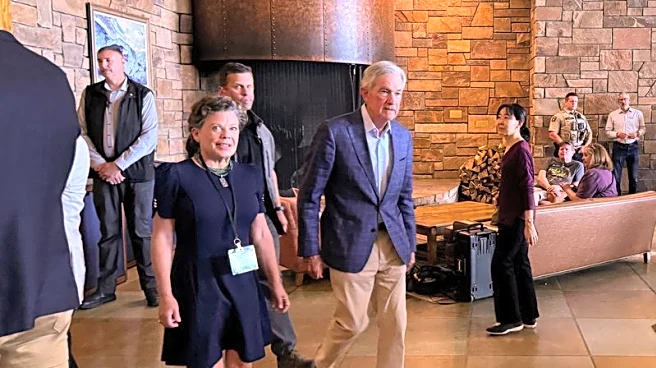Rapid Read • 8 min read
Federal Reserve officials have expressed a greater concern for inflation risks compared to employment issues, as revealed in the minutes from a recent policy meeting. The meeting highlighted a divide within the Federal Open Market Committee (FOMC) regarding the impact of President Trump's tariffs on the economy. While the majority of participants viewed the risk of rising inflation as more significant, a minority considered the potential downside to employment as more pressing. Despite President Trump's calls for interest rate cuts, the committee decided to maintain the current rate range of 4.25% to 4.50%. However, dissenting voices within the committee, including Fed governors Christopher Waller and Michelle Bowman, advocated for a 25 basis point cut to mitigate potential economic weakening and labor market damage. The minutes also noted that the effects of tariffs were becoming more evident in the form of increased goods price inflation, and that economic growth had slowed in the first half of the year.
AD
The Federal Reserve's focus on inflation over employment has significant implications for U.S. economic policy and stakeholders. By prioritizing inflation control, the Fed aims to prevent long-term inflation expectations from becoming unanchored, which could destabilize the economy. This approach may impact businesses and consumers by maintaining higher borrowing costs, potentially slowing economic growth. The decision to keep interest rates steady, despite calls for cuts, reflects the Fed's cautious stance in balancing inflation risks with economic stability. The ongoing debate within the FOMC highlights the challenges of navigating economic policy amid external pressures such as tariffs, which can affect both prices and employment. The outcome of this policy direction will influence financial markets, business investment decisions, and consumer spending patterns.
The Federal Reserve's next steps will likely depend on upcoming economic data, particularly employment reports. The August employment report and any revisions could be pivotal in determining whether the Fed decides to cut interest rates in September. Stakeholders, including businesses and investors, will closely monitor these developments to gauge the Fed's future policy direction. The ongoing impact of tariffs on inflation and employment will also be a critical factor in the Fed's decision-making process. As the economic landscape evolves, the Fed's ability to balance its dual mandate of stable prices and maximum employment will remain under scrutiny.
AD
More Stories You Might Enjoy











